Whitby
| Whitby | |
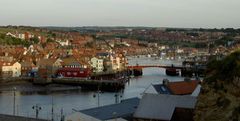 Whitby on the River Esk |
|
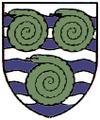 Arms of Whitby Town Council |
|
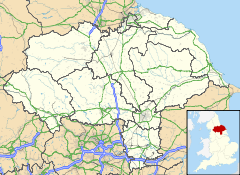 Whitby
|
|
| Population | 13,594 (2001 census)[1] |
|---|---|
| OS grid reference | |
| Parish | Whitby |
| District | Scarborough |
| Shire county | North Yorkshire |
| Region | Yorkshire and the Humber |
| Country | England |
| Sovereign state | United Kingdom |
| Post town | WHITBY |
| Postcode district | YO21, YO22 |
| Dialling code | 01947 |
| Police | North Yorkshire |
| Fire | North Yorkshire |
| Ambulance | Yorkshire |
| EU Parliament | Yorkshire and the Humber |
| UK Parliament | Scarborough and Whitby |
| List of places: UK • England • Yorkshire | |
Whitby is a town and civil parish in the Scarborough borough of North Yorkshire, England. It is situated 47 miles (76 km) from York, at the mouth of the River Esk and spreads up the steep sides of the narrow valley carved out by the river's course. At this point the coast curves round, so the town faces more north than east. According to the 2001 UK census, Whitby parish had a population of 13,594.[1]
Whitby was founded under its Old English name of Streonshal in 656, when Oswy, the Christian king of Northumbria, founded Whitby Abbey, under its first abbess Hilda. The Synod of Whitby was held here in 664. In 867, the monastery was destroyed by Viking raiders, and was only refounded in 1078. It was in this period that the town gained its current name, Whitby, (from "white settlement" in Old Norse). In the 18th century Whitby became a centre for shipbuilding and whaling, as well as trade in alum and jet.
Tourism and fishing now form the mainstay of the town's economy. There are rail and bus links to the rest of North Yorkshire and North East England. Whitby has featured in literary works, television and cinema; most famously in Bram Stoker's novel, Dracula.
Whitby area including entire skeletons of pterodactyls. Whitby is known for its well preserved ammonite fossils, which can be found on the seashore or purchased from stalls or shops in the town.
Three green ammonites are featured on the coat of arms of the Whitby Town Council. These ammonites are shown with a head carved on, as "snake stones", which were sold as religious souvenirs in memory of Saint Hilda of Whitby.[2]
Contents |
History
Names
The earliest recorded name for Whitby was the Old English Streonshal in 656. Streanæshalc, Streneshalc, Streoneshalch, Streoneshalh, Streunes-Alae in Lindissi were recorded spellings between the 6th and 8th centuries, Prestebi (meaning the habitation of priests in Old Norse) is a 9th century name. After the Norman Conquest it was recorded as Hwitebi, Witebi (meaning the white settlemen in Old Norse) in the 12th century, Whitebi in the 13th century and Qwiteby in the 14th century.[3]
Whitby Abbey
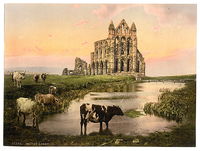
In about 656, Oswiu or Oswy, the Christian king of Northumbria, founded a monastery after defeating Penda, the pagan king of Mercia. Oswiu consecrated his infant daughter Ælflæda to the service of God. Oswiu granted 12 small estates monasteries to be built. One was at Streanæshealh, which became known as Whitby Abbey. Ælflæda entered as a pupil and later became abbess.[4]
The first abbess, Hilda was later venerated as a saint. Whitby became a centre of learning, and the poetry of Cædmon is an early example of Anglo-Saxon literature. The abbey was the leading royal nunnery of Deira, and burial-place of its royal family. The Synod of Whitby in 664, established the Roman date of Easter in Northumbria at the expense of the Celtic one.[5]
In 867, Danish Vikings landed 2 miles (3.2 km) west of Whitby at Raven's Hill, attacked the settlement and destroyed the monastery.[3] After the Norman Conquest of 1066 William de Percy ordered that the monastery be refounded (1078), dedicating it to St Peter and St Hilda.
Late-medieval and Tudor periods
In the reign of Elizabeth I, Whitby was a small fishing port. In 1540 it consisted of around twenty to thirty houses and had a population of about 200.[6] In that year, Henry VIII dissolved the monasteries, including Whitby Abbey.
At the end of the 16th century, Thomas Chaloner of York travelled to Italy and visited alum works in the Papal States.[7] He rock from which the alum was made was similar to that abundant around his Guisborough estate in North Yorkshire. Alum was a very important product, used internationally, in curing leather, fixing dyed cloths and for medicinal uses. The Vatican, and Spain, two countries in conflict with England, had maintained monopolies on the production and sale of the product. Chaloner secretly brought some of the Pope's workmen to England to develop the alum industry in Yorkshire. Once the alum industry had become established, the English Crown imposed its own monopoly - imports from abroad were banned. Although the methods were laborious, England became self-sufficient in alum.[8][9]
Whitby grew significantly as a port in the following years as a result of the transport of alum and coal; coal being transported from Durham to process the alum.[10]
Modern history - since 1605
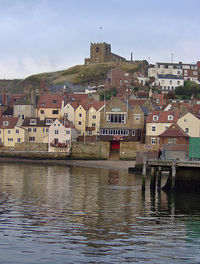

Several alum producing centres were established including, in 1615, one near Sandsend Ness 3 miles (5 km) from the town. Two new industries thus arrived in the port of Whitby—the transport of alum and that of the coal used in its production.
Whitby grew in size and wealth, extending its activities to include shipbuilding, using local oak timber as raw material. Taxes on imports entering via the port raised the finance to improve and extend the town's twin piers, improving the harbour and permitting further increases in trade. In 1753 the first whaling ship set sail to Greenland initiating a new phase in the town's development, and by 1795 Whitby had become a major centre for the whaling industry.
In 1839 George Hudson built the railway connecting Whitby to Pickering and York which played a part in the development of Whitby as a tourism destination. George Hudson was also responsible for the development of the Royal Crescent which was only partly completed.[11]
Whitby was the site of the Rohilla disaster of 30 October 1914, when the hospital ship Rohilla was sunk (either by running aground, or hitting a mine; accounts differ) within sight of shore just off Whitby. Eighty-five people lost their lives in the disaster; most of them are buried in the churchyard at Whitby.
Also in 1914, Whitby was shelled by German battlecruisers Von der Tann and Derfflinger, aiming for the signal post on the end of the headland. Scarborough and Hartlepool were also attacked. Whitby Abbey sustained considerable damage during the attack, which lasted ten minutes. The attack on Whitby was the final assault on the Yorkshire coast. The German squadron responsible for the strike escaped without capture despite an attempt made by the Royal Navy.
Geography
Whitby, on the North Sea coast, is situated in a deep valley at the mouth of the River Esk. The river banks are connected by a bridge of four arches, one of which is made of cast iron and swivels to open to allow vessels to pass. It was built on the site of an old drawbridge in 1835. The houses are built partly built of brick and partly of stone, in narrow, sometimes steep streets, on both sides of the river.[12]
Transport
The Port of Whitby is strategically placed for shipping to Europe, especially Scandinavia, and is capable of handling cargoes of grain, steel products, timber and potash. Vessels of up to 3,000 tonnes DWT are received at the wharf, which has the capability of loading/unloading two ships simultaneously. 54,000 square feet (5,000 m2) of dock space is currently (2004) allocated for storage of all-weather cargo and a further 17,000 square feet (1,600 m2) of warehouse space is reserved for weather-critical goods storage.
The town is served by Whitby railway station which forms the terminus of the Esk Valley Line from Middlesbrough, formerly the northern terminus of the Whitby, Pickering and York line. Whitby is also served by the Yorkshire Coastliner bus line (which can take travellers to and from Leeds, Tadcaster, York, Scarborough, Bridlington, Pickering, Malton and many more towns in Yorkshire) and the Arriva bus company, which runs services connecting Whitby to Scarborough and Middlesbrough. The 110-mile (180 km) Cleveland Way National Trail passes through Whitby. The town was awarded "Best Seaside Resort 2006", by Which? Holiday magazine.
Economy
Whitby has a fish market on the quayside which operates as need arises.[13] The ready supply of fresh fish has resulted in an abundance of "chippies" in the town, including the Magpie Cafe which Rick Stein has described as the best fish and chip shop in Britain.[14]
Education
Whitby Community College was granted specialist school status in September 2002, specialising in Technology.[15] There are several schools within Whitby:
|
Primary schools:
|
Secondary schools:
Independent Schools:
|
Landmarks
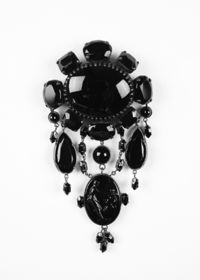
Over the centuries, the town has spread inland and onto the West Cliff, whilst the East Cliff, the Haggerlythe, is dominated by the ruins of Whitby Abbey and St Mary's Church. The Abbey is owned by English Heritage, which restored the Banqueting House for exhibitions and displays and opened it in 2002.
The East Cliff is at quite a distance by road, the alternative is to climb the 199 steps of the "Church Stairs" [16] or use the footpath called Caedmon's Trod".[17]
In West Cliff there is a statue of Captain James Cook, who served his apprenticeship in the town, and a whalebone arch, commemorating the once large whaling industry. The whalebone arch is the second such arch, the original is preserved in Whitby Archives Heritage Centre. By the inner harbour there is a statue commemorating William Scoresby, inventor of the crow's nest.
Whitby jet
The black mineraloid, jet, the fossilized remains of decaying wood,specifically that of the Monkey Puzzle Tree, is found in the cliffs around Whitby, and has been used since the Bronze Age to make beads and other jewellery. The Romans mined jet extensively, and Whitby jet was at the peak of its popularity in the mid-19th century, especially after it was favoured as mourning jewellery by Queen Victoria and the manufacture of jewellery from locally mined jet was one of Whitby's main industries.
Whitby Museum holds a large collection on the archaeological and social history of jet. It also displays a "Hand of Glory".
Whitby and literature
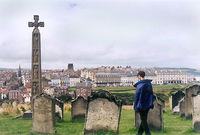
Part of Bram Stoker's famous novel Dracula was set in Whitby, and incorporated various pieces of Whitby folklore, including the beaching of the Russian ship Dmitri, which became the basis of Demeter in the book. Furthermore, it was at the original public library on Marine Parade in Whitby that Stoker discovered the name "Dracula."[18]
Elizabeth Gaskell sets her novel Sylvia's Lovers partly in Whitby.
Lewis Carroll stayed at 5 East Terrace in Whitby between July and September 1854, and his first publications seem to have been published in the Whitby Gazette.
In 1861 Wilkie Collins was in Whitby, accompanied by Caroline Graves, the inspiration for The Woman in White, to work on his novel No Name.
James Russell Lowell, the American writer, often visited Whitby while ambassador in London 1880-85, staying at 3 Wellington Terrace, West Cliff. On his last visit, in 1889, he wrote: 'This is my ninth year at Whitby and the place loses none of its charm for me.'
Margaret Storm Jameson, author, was born in Whitby.
Other literary works referencing Whitby include:
- Caedmon's Song by Peter Robinson
- Possession by A. S. Byatt
- The Hundred and Ninety Nine Steps by Michel Faber
- The Resurrectionists by Kim Wilkins
- The Whitby Witches by Robin Jarvis, that borrow from bits of local folklore
- Never the Bride, Something Borrowed, Conjugal Rites by Paul Magrs
- Fabulous Whitby, a 2008 anthology edited by S. Thomason and Liz Williams
Events
Whitby Regatta occurs annually for three days in August. Originally a rowing competition, it has expanded to include a large fair along the pier, police demonstrations, fireworks and military displays - including the spectacle of the [[Red Arrows.

Rowing forms a major part of the weekend and races take place over three days between three old rival clubs - Whitby Friendship ARC, Whitby Fishermen's ARC and Scarborough ARC.
Each year, on the eve of Ascension Day, the Penny Hedge ceremony is performed.
For over four decades the town has hosted the Whitby Folk Week, which currently includes around 600 different events in various venues. Whitby also hosts the bi-annual Whitby Gothic Weekend, a festival for members of the Goth subculture. "Whitby Now" has been, since 1991, an annual spectacular presentation of live music in the Whitby Pavilion. Originally planned by local musician Mark Liddell, the event has grown in size and popularity, featuring local acts such as The Yabbas and Steve Philips.[19] Since 2008 taking place in the end of October the Bram Stoker Film Festival.[20]
Cities twinned with Whitby
 Anchorage, Alaska, United States
Anchorage, Alaska, United States Porirua , New Zealand
Porirua , New Zealand Stanley, Falkland Islands
Stanley, Falkland Islands Whitby, Ontario, Canada
Whitby, Ontario, Canada Nukuʻalofa, Tonga
Nukuʻalofa, Tonga Kauai County, Hawaii
Kauai County, Hawaii
See also
- Raid on Scarborough, Hartlepool and Whitby (1914)
- Whitby Gazette
- Whitby Town F.C.
References
- ↑ 1.0 1.1 "2001 Census: Key Statistics: Parish Headcounts: Area: Whitby CP (Parish)". Neighbourhood Statistics. Office for National Statistics. http://neighbourhood.statistics.gov.uk/dissemination/LeadTableView.do?a=3&b=798227&c=whitby&d=16&e=15&g=476832&i=1001x1003x1004&m=0&r=1&s=1215427208070&enc=1&dsFamilyId=779. Retrieved 2009-11-04.
- ↑ "Genuki: Whitby History". www.genuki.org.uk. http://www.genuki.org.uk/big/eng/YKS/NRY/Whitby/WhitbyHistory.html. Retrieved 2008-08-19.
- ↑ 3.0 3.1 Page William (editor) (1923), "Parishes: Whitby", A History of the County of York North Riding: Volume 2, Victoria County History (British History Online): pp. 506–528, http://www.british-history.ac.uk/report.aspx?compid=64701, retrieved 2010-09-05
- ↑ Bede, The Ecclesiastical History of the English People, ed. J. McClure and R. Collins (Oxford University Press 1994), pp. 150-151.
- ↑ The Blackwell Encyclopaedia of Anglo-Saxon England ed. Michael Lapidge et al. (Blackwell 1999), pp.155, 472.
- ↑ "A Brief History - Whitby Sights". Whitbysights.co.uk. http://www.whitbysights.co.uk/whitby-history/abriefhistory.html. Retrieved 2009-08-02.
- ↑ "The history of alum in England". Wovepaper.co.uk. http://www.wovepaper.co.uk/alumessay2.html. Retrieved 2009-08-02.
- ↑ "North Yorkshire - Coast - Point 7 - Alum". BBC. 2005-07-21. http://www.bbc.co.uk/northyorkshire/content/articles/2005/07/21/coast05walks_stageseven.shtml. Retrieved 2009-08-02.
- ↑ "Taking the waters (From The Northern Echo)". Thenorthernecho.co.uk. 2008-07-26. http://www.thenorthernecho.co.uk/features/columnists/chrislloyd/3549153.Taking_the_waters/. Retrieved 2009-08-02.
- ↑ "Alum Quarrying". Fortunecity.com. http://www.fortunecity.com/greenfield/ecolodge/25/alum.htm. Retrieved 2009-08-02.
- ↑ "bbc.co.uk/northyorkshire". http://www.bbc.co.uk/northyorkshire/content/articles/2005/07/21/coast05walks_stagenine.shtml. Retrieved 2008-11-04.
- ↑ "Whitby", A Topographical Dictionary of England (British History Online): pp. 543–551, 1848, http://www.british-history.ac.uk/report.aspx?compid=51398#s6, retrieved 2010-09-05
- ↑ Whitby - Fishing
- ↑ Restaurant review, Daily Telegraph, 23 September 2006
- ↑ About Whitby Community College (Official website)
- ↑ CABE website
- ↑ "Background Information: Whitby Abbey". English Heritage. http://www.english-heritage.org.uk/server/show/nav.17365. Retrieved 2009-12-02.
- ↑ Bram Stoker's Notes for Dracula: A Facsimile Edition by Robert Eighteen-Bisang & Elizabeth Miller (McFarland, 2008), p. 244-46.
- ↑ 14-15 Nov: Whitby Now, Whitby Pavilion (North Yorkshire County Council website)
- ↑ Bram Stoker Film Festival - Offfical Site
Further reading
- Malcolm Barker - Essence of Whitby (2006) ISBN 1-90508-011-5
- Rosalin Barker - The Book Of Whitby (1990) ISBN 0 86023 462 2
- Colin Platt - Whitby Abbey (1985) ISBN 1 85074 456 4
- Cordelia Stamp - Whitby Pictorial Memories (2006) ISBN 1 85937 491 3
- Colin Waters - A History of Whitby's Pubs, Inns and Taverns (1992) ISBN 0 95192 380 3
- Colin Waters - Whitby, A Pictorial History (1992) ISBN 0 85033 848 4
- Colin Waters - Whitby Then and Now (2004) ISBN 0 75243 301 6
- Andrew White - A History of Whitby (2004) ISBN 1-86077-306-0
External links
- Whitby Web Cam Live 180 degree high resolution view of Whitby
- Mapping the Town: the history of Whitby, presented by Julian Richards (BBC Radio 4) (RealAudio format)
- Whitby at the Open Directory Project
- Tide times for Whitby from the BBC and Easytide.
|
||||||||
|
||||||||||||||||||||